

Time_data = tonecycles(amp, cycles, points) įigure 3 Making a specific power spectral density for simulation is not as easy as one might think. Points = 1000 % Number of points to generate % Make an input signal (Sine Wave Tone) based on number of cyclesĬycles = 3.95 % Number of cycles to make For scenario #1 above the function: “tonecycles.m” is used as shown in Figure 1. Starting with the generation of sine wave signals. If the data is in different units then it should be scaled appropriately back into Vrms units before continuing the signal processing. Note that in all these examples, and for the rest of this discussion, the units for the input signal are normally assumed to be in Vrms. To generate Gaussian white noise with a given Power Spectral Density (PSD) in real units that we analog folks use all the time, like: Vrms/√Hz. This is useful when thinking in terms of an actual digitized signal. This form is useful when I want to make a 10,000 point vector of a 10 kHz sine wave sample at a sampling rate of 100 kHz. Generate a deterministic signal based on a sampling approach.That way I can test windowing functions with whole and fractional cycles to easily determine amplitude accuracy, etc. Generate a deterministic signal with a known number of sine wave cycles.I have found that I need to generate deterministic signals in two forms: There are literally millions of function snippets on the Web for generating signals but they all use a different approach and that makes them hard to remember and reuse. When testing DFTs a method of quickly generating test signals is needed.

With Octave, data from any source may be analyzed and generally Octave is quicker than traditional programming languages when a solution needs to be developed fast.Įvery DFT analysis starts with an input signal These problems lead me to create a set of consistent analysis functions for Octave/MATLAB 2 that I use all the time for calibrated DFT signal and noise analysis in a unified, easy to remember, and consistent form.

All of this confusion leads to a lot of wasted time. While there are many examples on the Web of using DFT functions that show how to make a spectrum for signal analysis or power spectral density for noise analysis, many are not fully accurate, hard to use, or even worse, not compatible with each other.


 0 kommentar(er)
0 kommentar(er)
